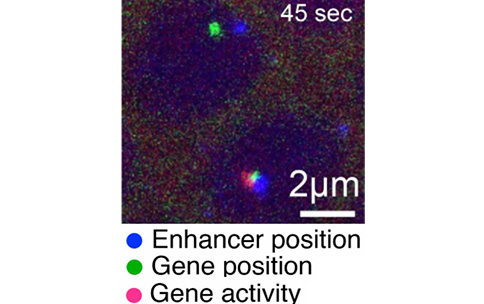
Genes are the segments of our DNA that code for proteins that determine our traits. Over 90% of our DNA does not encode genes and was long considered “junk” DNA that had no known purpose. We now know that much of this DNA does have a purpose, for example, some of this non-coding DNA contains enhancers- regions of DNA that help “turn on” genes to ultimately produce proteins. The timing of turning a gene on is very important for normal development and issues with timing can lead to development of disease. Enhancers are typically located far away from the gene they turn on, and how the enhancers find their target genes within the nucleus of the cell and how they interact with gene- coding regions to result in protein production is not well understood. In a recent study by 4D Nucleome program-funded investigator Dr. Thomas Gregor and his research team, a live imaging approach was used to track the position of an enhancer and its target gene in developing fly embryos, while also monitoring gene activity. Using this technique, they were able to observe the moment when a gene was turned on. The results showed that close proximity between the enhancer and target gene was required not only to turn the gene on, but also to keep the gene active. When the enhancer disconnected from the target gene, the gene turned off. They also found that when the gene was turned on, the structure formed by the enhancer and target gene became more compact, and the results suggest changes in the 3D DNA arrangement improve the stability of this structure, allowing the gene to remain active. The results of this study improve our understanding of how gene activity is regulated and may help provide insight into how improper regulation of gene activity leads to developmental defects and disease.
Reference
- Dynamic interplay between enhancer-promoter topology and gene activity. Chen, H, Levo, M, Barinov, L, Fujioka, M, Jaynes, JB, and Gregor, T. Nature Genetics. 2018.
In the News
- Imaging in living cells reveals how ‘junk DNA’ switches on a gene, Princeton University
- DNA Enhancer Video Rules Out Hit-and-Run Activity, Genetic Engineering & Biotechnology News


